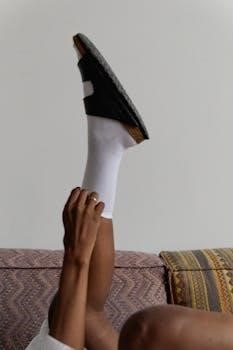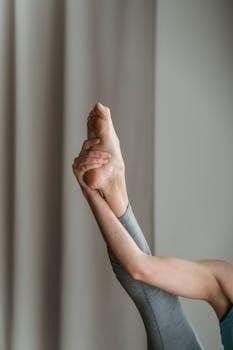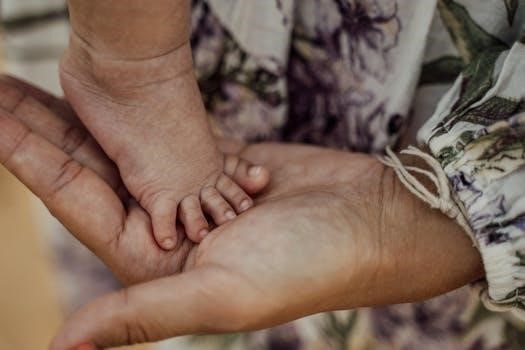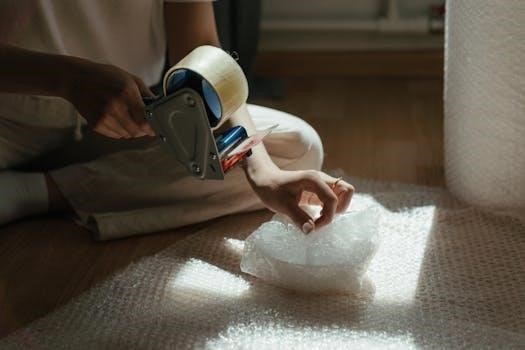
-
By:
- ophelia
- No comment
hand and foot instructions
The human hand and foot, while seemingly different, share fundamental anatomical similarities. Both are complex structures comprised of numerous bones, muscles, ligaments, tendons, nerves, arteries, and veins working in harmony. Understanding their anatomy is essential for healthcare providers and anyone interested in biomechanics.

Overview of Hand Anatomy
The hand, a marvel of engineering, enables fine motor skills and powerful grasping. Its intricate anatomy includes 27 bones, numerous muscles for precise movements, strong ligaments for joint stability, and tendons connecting muscles to bones. Nerves provide sensation, while arteries and veins supply blood and remove waste.
Bones of the Hand (Osteology)
The skeletal framework of the hand is composed of 27 bones, divided into three distinct regions⁚ the carpals (wrist), metacarpals (palm), and phalanges (fingers). The carpus consists of eight small carpal bones arranged in two rows. These bones articulate with the radius and ulna of the forearm, providing wrist flexibility.
The five metacarpal bones form the palm of the hand. Each metacarpal articulates with a carpal bone at its base and a phalanx at its distal end, contributing to hand shape and grasping ability.
The phalanges are the bones of the fingers. Each finger possesses three phalanges—proximal, middle, and distal—except for the thumb, which has only two (proximal and distal). These bones facilitate fine movements and manipulation. The osseous anatomy of the human hand is integral to its functionality.
Muscles, Ligaments, and Tendons of the Hand
The intricate movements of the hand are orchestrated by numerous muscles, ligaments, and tendons. The muscles are the structures that contract, allowing movement of the bones in the hand. These muscles can be divided into extrinsic and intrinsic groups. Extrinsic muscles originate in the forearm and insert into the hand, providing power and gross motor control. Intrinsic muscles are located within the hand itself, enabling fine motor skills and precise movements.
Ligaments are fibrous tissues that connect bones to each other, providing stability to the joints of the hand. They help bind together the joints in the hand.
Tendons are tough, fibrous cords that connect muscles to bones, transmitting the force generated by muscle contraction to produce movement. The sheaths are tubular structures. The interplay of these structures allows for the hand’s remarkable dexterity.
Nerves, Arteries, and Veins in the Hand
The hand’s functionality relies heavily on a complex network of nerves, arteries, and veins. Nerves provide sensory and motor innervation, enabling touch, temperature, pain perception, and muscle control. The main nerves of the hand are the median, ulnar, and radial nerves, each responsible for innervating specific regions and functions.
Arteries supply oxygenated blood to the hand, nourishing its tissues and supporting its metabolic demands. The radial and ulnar arteries are the primary sources of blood flow, forming an intricate network of smaller vessels within the hand.
Veins drain deoxygenated blood away from the hand, returning it to the systemic circulation. The venous drainage system parallels the arterial supply, ensuring efficient removal of waste products. The intricate interplay of these structures is essential for maintaining the hand’s health and function.

Overview of Foot Anatomy
The foot, a complex structure, supports weight, enables movement, and provides balance. Its anatomy comprises bones, muscles, ligaments, tendons, nerves, and blood vessels. Understanding these components is crucial for diagnosing and treating foot conditions and injuries.
Bones of the Foot (Osteology)
The foot’s skeletal framework is intricate, composed of 26 bones that provide structural support and facilitate movement. These bones are categorized into three main groups⁚ the tarsals, metatarsals, and phalanges. The tarsals, located in the hindfoot and midfoot, include the calcaneus (heel bone), talus, navicular, cuboid, and three cuneiform bones. These bones articulate to form the ankle joint and provide stability.
The metatarsals, five long bones in the midfoot, connect the tarsals to the phalanges. They contribute to the foot’s arch and flexibility. The phalanges comprise the toes, with each toe containing three phalanges (proximal, middle, and distal), except for the big toe, which has only two.
These bones work together to allow for a wide range of motion and weight distribution, essential for walking, running, and maintaining balance. The intricate arrangement of the foot bones is a testament to its evolutionary adaptation for bipedal locomotion. Understanding foot osteology is key to diagnosing various foot ailments.
Muscles, Ligaments, and Tendons of the Foot
The foot’s complex functionality relies on a network of muscles, ligaments, and tendons. Muscles are responsible for movement, ligaments connect bones providing stability, and tendons attach muscles to bones, transmitting force. Foot muscles are divided into intrinsic and extrinsic groups. Intrinsic muscles originate and insert within the foot, controlling fine movements of the toes.
Extrinsic muscles originate in the lower leg and insert into the foot, providing powerful movements for walking, running, and jumping. Key extrinsic muscles include the calf muscles (gastrocnemius and soleus), tibialis anterior, and peroneals. Ligaments, such as the plantar fascia, deltoid ligament, and lateral ligaments, stabilize the ankle and foot joints, preventing excessive motion.
Tendons, including the Achilles tendon and tibialis posterior tendon, transmit forces from muscles to bones, enabling movement. The intricate interplay of these structures allows the foot to withstand significant forces while maintaining flexibility and balance. Injuries to muscles, ligaments, and tendons are common foot problems.

Comparison of Hand and Foot Anatomy
The hand and foot, though adapted for different functions, exhibit striking anatomical parallels. Examining their similarities and differences provides insight into their evolutionary origins and specialized roles in manipulation and locomotion, respectively, for current and future healthcare providers.
Similarities in Structure and Function
Despite serving distinct purposes, the hand and foot share several key structural and functional similarities. Both possess a complex skeletal framework comprised of numerous small bones⁚ the carpals/tarsals, metacarpals/metatarsals, and phalanges. This segmented design allows for a wide range of motion and flexibility.
Both the hand and foot rely on intricate networks of muscles, tendons, and ligaments to control movement and provide stability. These soft tissues work in concert to facilitate both gross motor actions and fine motor manipulations.
Furthermore, both structures are richly innervated with sensory receptors, enabling them to perceive touch, pressure, temperature, and pain. This sensory feedback is crucial for coordinating movement and maintaining balance.
Both depend on similar circulatory systems, and both are critical for interacting with the environment. These shared features reflect their common evolutionary ancestry and the fundamental principles of vertebrate limb design.
Key Differences in Anatomy
While the hand and foot exhibit similarities, their unique functions necessitate significant anatomical differences. The hand is optimized for grasping and manipulation, featuring a highly mobile thumb capable of opposition. In contrast, the foot is designed for weight-bearing and locomotion, with a more rigid arch structure for stability.
The arrangement and size of bones differ considerably. The hand’s carpal bones are smaller and more loosely connected than the foot’s tarsal bones, allowing for greater wrist mobility. The foot’s metatarsals are thicker and more robust to withstand compressive forces;
Muscle distribution also varies. The hand possesses numerous intrinsic muscles for fine finger movements, while the foot relies more on extrinsic muscles originating in the lower leg for powerful ankle and toe actions.
Finally, sensory receptor density differs, with the hand having a higher concentration of touch receptors for precise tactile discrimination. These distinctions reflect the specialized roles of each structure in interacting with the world.

Common Hand and Foot Conditions & Injuries
The intricate anatomy of the hands and feet makes them susceptible to a variety of conditions and injuries. In the hand, carpal tunnel syndrome, triggered by median nerve compression, is a frequent ailment. Arthritis, including osteoarthritis and rheumatoid arthritis, can cause joint pain and stiffness. Trigger finger, characterized by a snapping sensation during finger movement, arises from tendon inflammation. Fractures, sprains, and dislocations are common injuries resulting from trauma.
Foot problems include plantar fasciitis, which causes heel pain due to inflammation of the plantar fascia. Bunions, hallux valgus deformities, affect the big toe joint. Ankle sprains are prevalent injuries, involving ligament damage. Stress fractures, tiny cracks in the bone, can occur from repetitive impact. Fungal infections, such as athlete’s foot, are also common. These conditions can significantly impact mobility and daily activities, emphasizing the importance of proper care and timely medical attention.
Hand and Foot Care Instructions
Maintaining optimal hand and foot health requires consistent care and attention. For hands, regular moisturizing helps prevent dryness and cracking, especially after washing. Proper handwashing techniques, using mild soap and warm water, minimize the risk of infection. Protecting hands from extreme temperatures and harsh chemicals is crucial. Stretching exercises can improve flexibility and reduce stiffness. Addressing hand pain or discomfort promptly is vital for preventing chronic issues.
Foot care involves wearing supportive shoes with adequate cushioning. Regularly trimming toenails straight across prevents ingrown nails. Keeping feet clean and dry minimizes the risk of fungal infections. Moisturizing dry skin, especially on the heels, prevents cracking. Performing foot exercises can improve circulation and flexibility. Inspecting feet regularly for cuts, blisters, or abnormalities allows for early detection and treatment of potential problems. Seeking professional help for persistent foot pain or deformities ensures proper management and prevents further complications.